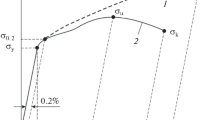Abstract
Methodical questions concerning determination of the crack-resistance characteristics of structural materials are addressed. Fracture-toughness characteristics, which are established from methods proposed in existing regulatory documents may have a 22% spread evoked by objective factors. One means of reducing this spread is the computer processing of load-displacement diagrams.
A method of approximating the load-displacement diagrams, which is based on the use of spline functions, is proposed and substantiated. The accuracy of approximation of these diagrams is confirmed. Good correspondence is indicated between computer and experimental data.
An example is given for the calculation of crack-resistance characteristics in accordance with the proposed method.
Similar content being viewed by others
Literature cited
Republican Document 50-260-81. Methodological Instructions. Strength Calculations and Tests in Machine Building. Methods of Mechanical Testing of Metals. Determination of Fracture Toughness (Crack Resistance) under Static load [in Russian], Izd. Standartov, Moscow (1982).
GOST 25.506-85. Strength Calculations and Tests. Methods of Mechanical Tests of Metals. Determination of Crack-Resistance (Fracture-Toughness) Characteristics under Static Load [in Russian], introduced March 27, 1985.
V. A. Volkov, A. M. Orestov, G. P. Karzov, et al., Experimental evaluation of the applicability of methodological instructions for determination of the crack-resistance characteristics of low-strength steels, Unification of Methods of Crack-Resistance Tests [in Russian], No. 2, Izd. Standartov, Moscow (1982), pp. 10–31.
A. Peiter, W. Lode, A. Keller, and K. Hilt, “Ausleichsfunktionen fur Spannung-Dehnung-Kurven zur numerischen Ermittung elastischer und plastischer Kennwerte,” Fachberichte fur Metallbearbeitung,61, No. 7–8, 260–265 (1984).
Yu. S. Zav'yalov, V. I. Kvasov, and V. L. Miroshnichenko, Methods of Spline Functions [in Russian], Nauka, Moscow (1980).
V. E. Kraskevich, K. Kh. Zelenskii, and V. I. Grechko, Numeric Methods in Engineering Calculations [in Russian], Vishcha Shkola, Kiev (1986).
Author information
Authors and Affiliations
Additional information
Translated from Problemy Prochnosti, No. 10, pp. 29–32, October, 1990.
Rights and permissions
About this article
Cite this article
Novogrudskii, L.S., Limanskii, I.V. & Kopanev, A.A. Method of calculating strain work in determining crack-resistance characteristics. Strength Mater 22, 1418–1422 (1990). https://doi.org/10.1007/BF00767222
Received:
Issue Date:
DOI: https://doi.org/10.1007/BF00767222




